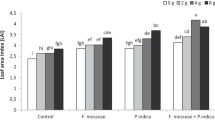Abstract
This paper presents the study results on the effect that presowing seed treatment and spraying nitrogen-fixing, phosphate-, and potassium-solubilizing bacteria on the seedlings of the Primorskaya 39 spring soft wheat (Triticum aestivum L.) cultivar have on the structural elements of productivity, yield, and the number of soil microorganisms. It was found that the total number of bacteria increases in the waxy ripeness stage when using both presowing treatment of seeds and spraying the microorganism strains on the seedlings. The maximum number of bacteria in the soil was detected in the variants when using strains of nitrogen-fixing and potassium-solubilizing microorganisms in presowing treatment (1.9 × 107 CFU/g of soil) and phosphate- and potassium-solubilizing microorganisms when spraying the seedlings (2.0 × 107 CFU/g of soil). The variant N1 + K2 + P6 after presowing treatment with nitrogen-fixing, potassium-, and phosphate-solubilizing microorganisms in the waxy ripeness stage showed the highest content of mobile phosphorus (92 mg/kg). High yield (4.3 t/ha) was shown by the variant N1 + P19 after presowing seed treatment with nitrogen-fixing and phosphate-solubilizing strains.


Similar content being viewed by others
REFERENCES
Dmitriev, N.N. and Gamzikov, G.P., Systematic use of fertilizers as a factor in stabilizing the fertility of gray soils and the productivity of grain crops in grain-fallow crop rotation, Agrokhimiya, 2015, no. 2, pp. 3–12.
Fertilizer Review. National Fertilizer Development Center (NFDC), Planning and Development Division, Publication No. 3/2002, Islamabad, 2002.
Tekhnologiya effektivnogo primeneniya bakterial’nykh preparatov dlya povysheniya produktivnosti sel’skokhozyaistvennykh kul’tur v stepnoi zone Povolzh’ya (Technology for the Effective Use of Bacterial Preparations to Increase the Productivity of Agricultural Crops in the Steppe Zone of Volga Region), Yaroshenko, T.M., Zhuravlev, D.Yu., Klimova, N.F., and Kulikova, V.A., Eds., Saratov, 2017.
Vance, C.P., Symbiotic nitrogen fixation and phosphorus acquisition. Plant nutrition in a world of declining renewable resources, Plant Physiol., 2001, vol. 127, no. 2, pp. 390–397.
Bykovskaya, A.N., Sidorenko, M.L., Sleptsova, N.A., Klykov, A.G., Berezhnaya, V.V., and Kolesnikova, D.A., The use of agronomically valuable bacteria to increase soil fertility and yield of spring barley (Hordeum vulgare L.), Vestn. Dal’nevost. Otd. Ross. Akad. Nauk, 2020, no. 1, pp. 75–82. https://doi.org/10.25808/08697698.2020.209.1.008
Kefeli, V.I. and Sidorenko, O.D., Fiziologiya rastenii s osnovami mikrobiologii (Plant Physiology with Basics of Microbiology), Moscow: Agropromizdat, 1991.
Novye tekhnologii proizvodstva i primeneniya biopreparatov kompleksnogo deistviya (New Technologies for the Production and Use of Complex Biological Products), Zavalin, A.A. and Kozhemyakov, A.P., Eds., St. Petersburg: Khimizdat, 2010.
Defreita, J.R. and Germida, J.J., Plant growth promoting rhizobacteria for winter wheat, Can. J. Microbiol., 1990, vol. 36, pp. 265–272.
Metody pochvennoi mikroflory i biokhimii (Methods for Research of Soil Microflora and Biochemistry), Zvyagintsev, D.G., Ed., Moscow: Mosk. Gos. Univ., 1991.
Praktikum po biologii pochv (Manual on Soil Biology), Zenovaya, G.M., Ed., Moscow: Mosk. Gos. Univ., 2002.
Dospekhov, B.A., Metodika polevogo opyta (s osnovami statisticheskoi obrabotki rezul’tatov issledovanii) (Methodology of Field Experiments (with Basics of Statistical Processing of Research Results)), Moscow: 2014.
Devlikamov, M.R., Effect of bacterial preparations and microelements on yield and grain quality of spring wheat in the forest-steppe of the Middle Volga region, Cand. Sci. (Agric.) Dissertation, Pensa, 2007.
Mishustin, E.N., Assotsiatsii pochvennykh mikroorganizmov (Associations of Soil Microorganisms), Moscow: Nauka, 1975.
Zvyagintsev, D.G., Pochva i mikroorganizmy (Soil and Microorganisms), Moscow: Mosk. Gos. Univ., 1987.
Yagodin, B.A., Zhukov, Yu.P., and Kobzarenko, V.I., Agrokhimiya (Agrochemistry), Moscow: Kolos, 2002.
Mishustin, E.N. and Emtsev, V.T., Mikrobiologiya (Microbiology), Moscow: Agropromizdat, 1987.
Wahid, F., Sharif, M., Khan, M.A., Ali, A., Khattak, A.M., and Saljoqi, A.R., Addition of rock phosphate to different organic fertilizers influences phosphorus uptake and wheat yield, Cienc. Tec., 2015, vol. 30, pp. 91–100.
Kharakteristika agrozemov Primor’ya: Kollektivnaya monografiya (Characteristics of Agricultural Land in Primorye: Collective Monograph), Slabko, Yu.I. and Sinel’nikov, V.I., Eds., Ussuriisk: GTsAS Primorskii, DVO DOP RAN, 2001.
Author information
Authors and Affiliations
Corresponding author
Ethics declarations
The authors declare that they have no conflict of interests. This article does not contain any studies involving animals or human participants performed by any of the authors.
Additional information
Translated by K. Lazarev
About this article
Cite this article
Berezhnaya, V.V., Klykov, A.G., Sidorenko, M.L. et al. Use of Microbial Strains to Increase Yields of Spring Soft Wheat (Triticum aestivum L.). Russ. Agricult. Sci. 47, 1–5 (2021). https://doi.org/10.3103/S1068367421010043
Received:
Accepted:
Published:
Issue Date:
DOI: https://doi.org/10.3103/S1068367421010043




